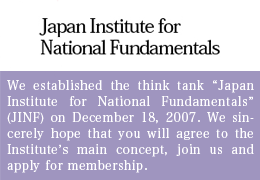THREATS FROM ISIS AND CHINA CALL FOR FURTHER REINFORCEMENT OF JAPANESE SELF-DEFENSE CAPABILITIES
The Japan Institute for National Fundamentals (JINF), a privately-financed think tank that I head, held a seminar in Tokyo on November 23 entitled “Puzzling Cold War in South China Sea between the US and China.” Chinese aggression in the sea in question will most likely be repeated in the East China Sea. Without doubt, Beijing is out to declare most of the South China Sea as its inland sea by wresting disputed islets from its Southeast Asian neighbors, reclaiming land around them, and then turning them into military bases. The minute it judges Japan can be overwhelmed by force, China will take the same strong line as it has in the South China Sea in a determined effort to deprive Japan of the Senkaku Islands, claiming most of the East China Sea as its own territory.
While China’s intent is quite obvious, one is genuinely puzzled by the current relationship between Washington and Beijing. The US appears to be exercising extreme diffidence toward China, while the latter also responds with restraint. In the 1970s, the two nations joined hands with each other over Japan’s head as they took steps to normalize diplomatic relations. With this history in mind, the purpose of our seminar was to explore how Japan should cope with the present situation in the South China Sea.
Obviously, these matters cannot be discussed thoroughly without taking into consideration the terrorist forces that have shaken the international community. Professor Tadae Takubo, an international affairs expert who serves as JINF’s deputy director, describes as “Apocalypse Now” the current situation created by Islamic fundamentalism forces which have spread rapidly from the Middle East to Africa to Europe. Many nations have tried unsuccessfully to contain Islamic terrorists, to whom indiscriminate slaughter is seen as justice.
The world situation changed dramatically on November 13 when Islamic terrorists attacked Paris. Only three days later, President Putin of Russia—who had been in conflict with the US and Europe over Crimea—took to calling France its “ally.” The US, Britain, France, and Russia have now formed a united front against the Islamic State in Iraq and Syria (ISIS).
Even if the US and Europe stand shoulder to shoulder with Russia, putting aside the Crimean issue provisionally and giving priority to the annihilation of ISIS over the resignation of Assad, one must still question the chances for success of such a coalition. While effective countermeasures have yet to be worked out, one can be reasonably sure of the major cause behind the abnormal rise of Islamic terrorist forces—the sorry failure of America’s Middle East policy.
“Moral Equivalent of American Founding Fathers”
The seeds for today’s disastrous situation were planted back in the late ‘70s. During Afghanistan’s war against the Soviet Union (1978-1989), the CIA trained Afghan guerillas by providing them a variety of weapons, utilizing oil dollars from the Middle East and the Inter-Service Intelligence, Pakistan’s notorious military intelligence outfit.
Professor Brahma Chellaney, one of India’s leading strategists, points out that in 1985 President Reagan invited Afghan Mujahideen commanders to the White House. A photograph showing Reagan in conversation with the leaders of Mujahideen, known today as merciless guerilla fighters, can be seen in the Ronald Reagan archives in Washington. Chellaney quotes Reagan as declaring then: “These gentlemen are the moral equivalent of our founding fathers.”
The Reagan administration used Islam as an ideological tool, encouraging Mujahideen to wage jihad (a holy war), Chellaney further points out. This is known to be the origin of Al Qaeda, which ISIS has by now surpassed many fold in universal appeal. The US has again ended up allowing the rise of a terrorism force—for different reasons.
Barely a year ago, ISIS dramatically showed off its presence to the world. On August 19, 2014, they beheaded American journalist James Foley in retaliation for US airstrikes against ISIS positions in northern Iraq. Within the month of September that year alone, ISIS murdered hostages from the US, Britain, and France; Japanese hostages Haruna Yukawa and Kenji Gogo were also beheaded on January 24 and 31 respectively, as shown in horrific video clips.
As ISIS’s slaughterous stage of operations expanded across Europe, a significant number of indigenous youths from EC nations volunteered to be jihadists, the scope of ISIS activities having increased to 22 nations within a year.
On September 16, General Lloyd Austin, Commander of the United States Central Command (USCC), announced that “only four or five” of a total of 54 US-trained moderate Syrian fighters still remained in the fight against ISIS. To this day, the US Defense Department has yet to trace the rest of these specially trained fighters.
In point of fact, rumors are that the “moderate” jihadists trained by the CIA may possibly have joined ISIS, carrying the weapons provided by the US. It can be said that ISIS is committing terrorist acts against Western nations utilizing US-provided weapons and US-trained fighters.
For Japan, terrorism is not somebody else’s business: there is a distinct possibility that Japan itself could be the target of a terrorist attack. At the same time, the nation faces another serious threat—from China.
Early in the last decade, China managed to get over a major crisis in its relations with the US by using the 9/11 terrorist attacks to its advantage. In January 2001, when he assumed the presidency, George Bush criticized his predecessor Bill Clinton for having developing a pro-China foreign policy, treating China as America’s “strategic partner.” Bush redefined the country as America’s “rival state,” declaring Japan—not China—was its strategic partner in Asia Pacific.
“Godzilla in the Backyard”
Eight months later, on September 11, 2001, Islamic terrorists launched an attack on the US. America’s chief adversary was now the terrorists, and China lost no time in making overtures towards the US. Beijing, which has more than 8 million Islamic Uyghurs within its orders, joined hands with Washington, promising to provide coveted terrorist-related intelligence. And thereafter the Chinese started to openly suppress the Uyghurs, killing two birds with one stone.
Prior to the November 13 terrorist attack in Paris, China had been isolated in the international community, again primarily due to its aggression in the South China Sea.
The US has refused to recognize Chinese sovereignty over man-made islands in the South China Sea, dispatching a guided missile destroyer (the USS Lassen) inside the 12 nautical mile territory claimed by China around of one of the artificial islets in the Spratly Islands—albeit rather timidly.
If US military operations against ISIS are to be intensified as a result of the Paris attack, developments in the South China Sea most likely cannot help being affected one way or another. If US surveillance in the South China Sea weakens, China unquestionably will resume its bold acts of aggression on the high seas against international norms and laws.
Of Japan’s posture towards China, Former Defense Minister Itsunori Onodera told the seminar it was “like leaving a neighbor alone to breed a Godzilla in our own backyard,” admitting that Japan has led China to self-righteousness by not asserting itself on a number of critical issues, including the Senkakus. Onodera stressed it is all the more significant that the administration of Prime Minister Shinzo Abe managed to pass the security bills this year, expanding the international security role of the Japan Self-Defense Forces (JSDF). During the East Asian Summit in Kuala Lumpur on November 22, most of the participating nations were critical of Chinese actions in the South China Sea, proving that the terrorist attack in Paris did little to abate protests among most Asian leaders against China’s blatant disregard of international law.
And yet, both Abe and Onodera are discreet about the possible role JSDF could very well play in jointly patrolling the South China Sea with the US Navy. Koichi Furusho, former Chief of Staff of the Japan Maritime Self-Defense Force, had this to say:
“Japan cannot possibly watch all fronts—maintaining anti-piracy activities off Somalia; checking the activities of Chinese warships in the East China Sea; strengthening the defense of the entire Japanese archipelago; and conducting surveillance in the South China Sea as well.” In a nutshell, Furusho was admitting that the JSDF at this stage is not sufficiently equipped to perform all of these duties simultaneously. Plainly speaking, the present caliber of the JSDF is not enough to take care of all of Japan’s defense needs. One must conclude that, whether fending for itself against terrorism or China, Japan really has no choice but to strengthen its self-defense capabilities—step by step as fast as possible.
(Translated from “Renaissance Japan” column no. 682 in the December 3, 2015 issue of The Weekly Shincho)








